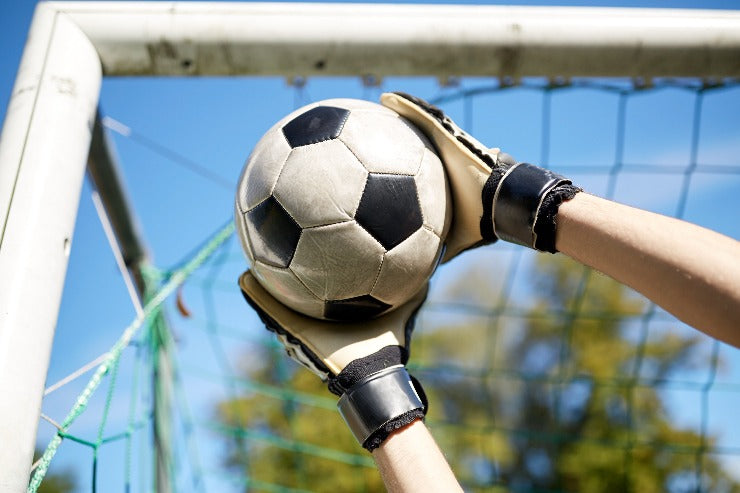Being a goalkeeper is highly challenging and choosing the right gloves can make a big difference. What’s the right cut? How big is too big? And what about grip? Here’s everything you need to know before you buy your next pair of goalie gloves.
When buying goalie gloves, there are many factors to consider such as hand size, skill level, injury risk, and performance. Choosing the right gloves for younger or more inexperienced players can be even more confusing. For parents and players, here’s an overview of what you should know about goalie gloves so you can choose the right pair.
Four Basic Components of Goalie Gloves
-
Palm – The goalie catches the ball with the palm, so better grip makes for a better glove, but durability and comfort also need to be considered.
-
Closure – This feature affects how the goalie puts on and takes off the gloves as well as how securely the glove fits on their hand.
-
Cut – The glove cut can impact the goalie’s level of comfort, flexibility and how it feels when catching and securing the ball.
Individual preference is a huge factor when it comes to choosing goalie gloves. While younger players need gloves that prioritize injury prevention and skill development, as players gain experience and confidence, they can choose gloves based on what feels comfortable and works best for them.
Selecting the Right Cut
Some people have long fingers with narrow palms, while others have short fingers and a wide palm. The “cut” of a glove reflects these differences and more. There are several different types of cut to choose from:
-
Flat Cut – Tends to have a boxier look, the flat cut provides a looser fit, allowing for more hand and finger movement. This is a good choice for beginners and younger players as well as players with wider hands.
-
Negative cut – With the seam on the inside of the glove, the negative cut offers a tight fit and better control.
-
Roll cut – A slightly thicker option compared to the negative cut, a roll cut glove offers gusset-less, curved fingers that allow more contact with the ball.
-
Hybrid cut – As the name suggests, the hybrid mixes elements of the flat and negative cuts.
Finger Protection
Finger protection refers to the plastic inserts that may be added to the fingers of certain styles of gloves. These spines help provide support and protect fingers from hyperextension when dealing with high impact shots. Finger protection gloves are a good choice for young or beginning goalkeepers to protect from injury as they learn. For a more advanced goalkeeper, this will be purely a personal preference.
Correct Sizing
Having the right size glove helps young goalkeepers make better ball contact. Too tight and the gloves are uncomfortable; too loose and the goalie won’t be able to properly grip the ball. The best fit is somewhere between loose and snug. Trying on the gloves is the best way to determine fit. Players can also have their hands measured, from the tip of their middle finger to the end of their palm. They should choose gloves that extend about .5- 1” past their fingertips.
Selecting the Grip
Grip and pricing go hand in hand – the better the grip, the higher the price. However, there tends to be an inverse relationship between durability and grip – the higher the grip quality, the less durable the glove. Experienced goalkeepers may want to invest in a higher quality glove for match play, while using a more affordable glove for training. Younger or beginner goalkeepers can opt for an entry level glove while they learn basics.
Tips for Taking Care of Goalie Gloves
-
Game day vs. Training – As mentioned above, it is a good idea to have two pairs of gloves, one for game play and one for practice so players don’t wear out game gloves during training. Some players start out the season with new gloves for games and use their old game gloves for practice.
-
For Better Grip – To get the most grip out of your gloves, some goalkeepers dampen the palms with water before using them.
-
Protecting the Grip – Avoid unnecessary abrasion. Do not allow the latex of your palm to touch the Velcro on your wrist strap when taking off your gloves. In training, do not get up using your palms, instead push yourself up with your fist.
-
Cleaning – Wash your gloves in warm water and allow them to dry naturally. It is important to treat your gloves gently. Do not use a scrubber or apply heat to dry your gloves. Never wash goalkeeper gloves in a washing machine.
-
Storing – Store your gloves in a cool environment. Do not leave them out in a hot, dry environment (such as the hot car or laying out in the sun).
To help your goalkeeper start the season out right, stop by European Sports. We are all about soccer and have stores located in Schaumburg, Glen Ellyn and Naperville. As a family-owned business, our goal is to make soccer fun and affordable for your entire family.

